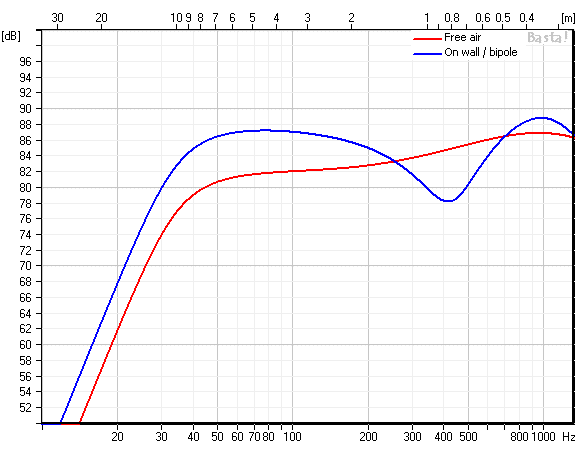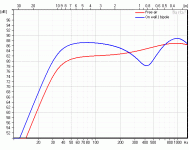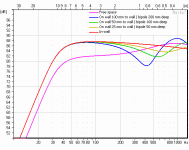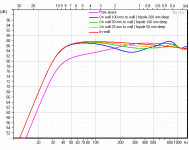Just brainstorming and searching for enclosure designs that try to minimize baffle step....
One idea that I had for an enclosure is a double BR with the higher tuning to give a +6 dB bump in the response. Thus the high tuning would negate the baffle step loss, and the low tuning would soften the sharp dropoff in bass that would otherwise result if a single BR were used.
Any information and/or musings would be appreciated. I don't often see very much posted on this, the forum is typically split between the "just address it with the crossover" and "crossovers are evil" camps There probably are more rigorous or more elegant approaches to this out there
There probably are more rigorous or more elegant approaches to this out there 
One idea that I had for an enclosure is a double BR with the higher tuning to give a +6 dB bump in the response. Thus the high tuning would negate the baffle step loss, and the low tuning would soften the sharp dropoff in bass that would otherwise result if a single BR were used.
Any information and/or musings would be appreciated. I don't often see very much posted on this, the forum is typically split between the "just address it with the crossover" and "crossovers are evil" camps

knorke said:To adress baffle step elegantly build a bipol....
OK, that puts you in camp #2
Anybody else from camp #1 or an outsider want to speak up
needs a bit of updating to include using horn-gain to compensate, and that a bipole should be wider than it is deep.
http://www.t-linespeakers.org/tech/bafflestep/intro-bds.html
trying to get the extra gain out of a BR may land you with a speaker with a hiQ lumpy bass...
dave
http://www.t-linespeakers.org/tech/bafflestep/intro-bds.html
trying to get the extra gain out of a BR may land you with a speaker with a hiQ lumpy bass...
dave
planet10 said:trying to get the extra gain out of a BR may land you with a speaker with a hiQ lumpy bass...
dave
Thanks Dave. That's what I was wondering; how bad is that high Q sound if it's tempered with some low end. Don't the car audio kids build for high Q intentionally for whatever purposes?
leadbelly said:
Just brainstorming and searching for enclosure
designs that try to minimize baffle step....
One idea that I had for an enclosure is a double BR
with the higher tuning to give a +6 dB bump in the response.

Hi,
Given the above needs two drivers a 0.5 way is far more elegant.
The power handling in the lower bass of your high tuned section
to put it in a word will be "pathetic". As alluded to by P10 the
sacrifice of good upper bass group delay will not sound good.
leadbelly said:OK, that puts you in camp #2
Actually I never did build a bipol, but I think it is
a elegant way
I build mostly multi way systems where a xo is needed
anyway. This puts me in camp#1....
knorke said:To adress baffle step elegantly build a bipol....
Mm, the problem is that it does not work for most geometries. A bipole is equivalent to hanging one loudspeaker on a rigid wall. Doing so, there will be a delay from the back side to the front side and the response ends up something like this:
Note the dip at ~400 Hz. This box is only 200mm deep (the on-wall box is 100 mm) and the baffle is 200 by 300 mm.
Attachments
Svante said:Note the dip at ~400 Hz. This box is only 200mm deep (the on-wall box is 100 mm) and the baffle is 200 by 300 mm.
Svante,
Can you do a series of plots where the box gets wider than it is deep?
At what distance is the plot simulating? (listening distance is more appropriate than 1m)
dave
Damn i wish that tool ran under OS X
Svante said:
Mm, the problem is that it does not work for most geometries. A bipole is equivalent to hanging one loudspeaker on a rigid wall. Doing so, there will be a delay from the back side to the front side and the response ends up something like this:

Note the dip at ~400 Hz. This box is only 200mm deep (the on-wall box is 100 mm) and the baffle is 200 by 300 mm.
Everything has its price...
Building the cabinet wider than deep as planet10 wrote will help and you will get cancellation of t driving forces from a bipol...
Svante said:A bipole is equivalent to hanging one loudspeaker on a rigid wall.
Does modeling it as a box on a wall take into account that the rear driver will be radiating more & more into 2 pi as you go above the BS frequency? (ie rear driver radiation is now only contributing as time delayed energy bouncing off the rear (& maybe side) walls?
dave
edit: hmmm: probably yes.
knorke said:Everything has its price...
And at least in this instance, the dip is likely close to the floor bounce... which may well be dominant.
dave
We have to look at real world situations.
A bipol in free space will have a dip in its response due the
delayed rear driver. A monopol simulated with a rear wall will have also have the dip. What do things look like
in a rectangular room with six sides? In fact you will get dips and humps with every speaker in a "normal" room....
A bipol in free space will have a dip in its response due the
delayed rear driver. A monopol simulated with a rear wall will have also have the dip. What do things look like
in a rectangular room with six sides? In fact you will get dips and humps with every speaker in a "normal" room....
planet10 said:needs a bit of updating to include using horn-gain to compensate
Does it have to be a horn or do you mean anything that's quarter-wave?
planet10 said:
Svante,
Can you do a series of plots where the box gets wider than it is deep?
At what distance is the plot simulating? (listening distance is more appropriate than 1m)
dave
Damn i wish that tool ran under OS X
The simulation is far field. Moving the "microphone" closer makes the dip slightly less deep.
I have experimented previously with boxes "wider than deep", but it turns out that if the magnet is not to go through the back wall, the box typically needs to be ~500-800 mm wide.
planet10 said:
Does modeling it as a box on a wall take into account that the rear driver will be radiating more & more into 2 pi as you go above the BS frequency? (ie rear driver radiation is now only contributing as time delayed energy bouncing off the rear (& maybe side) walls?
dave
edit: hmmm: probably yes.
Yes.
Attachments
knorke said:We have to look at real world situations.
A bipol in free space will have a dip in its response due the
delayed rear driver. A monopol simulated with a rear wall will have also have the dip. What do things look like
in a rectangular room with six sides? In fact you will get dips and humps with every speaker in a "normal" room....
Yes, it is true that room reflections give similar effects, in particular if they are few. Multiple reflections seem to "smear" the effect of the dips, since they are many and occur at different frequencies.
There is however two things that makes this first reflection from a wall or a bipole configuration different from the case with room reflections: This reflection occurs early, and if comes from approximately the same direction as the loudspeaker.
Perceptually there is a difference. Out brains know that any sound from where the loudspeaker stands will have a dip due to the floor reflection. A dip that is caused by a reflection in the direction of the loudspeaker cannot be differentiated from if that dip was in the loudspeaker itself. There are no perceptual cues for that.
leadbelly said:Just brainstorming and searching for enclosure designs that try to minimize baffle step....
There probably are more rigorous or more elegant approaches to this out there
Linkwitz Pluto
Baffle step occurs at ~3KHz beyond which decreasing power response with frequency is desired so no correction is needed and there aren't problems with on-axis and power response varying with frequency.
If you are going to correct baffle step, note that
1) Bass loudness perception seems to be more a function of total power response over time than just the direct sound, and if you correct the full 6dB you're going to have too much.
2) A stereo pair of speakers add as uncorrelated sources at high frequencies (+3dB) and correlated sources at low frequencies (+6dB).
John Krevosky has some interesting notes here
John Krevosky single speaker baffle step correction
John Krevosky stereo power response with baffle step correction
- Status
- This old topic is closed. If you want to reopen this topic, contact a moderator using the "Report Post" button.
- Home
- Loudspeakers
- Multi-Way
- Box designs that address baffle step?


